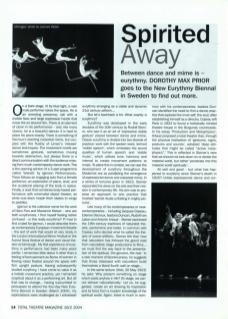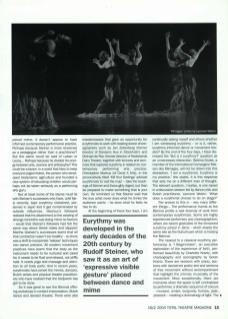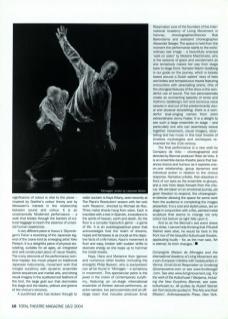On a bare stage, lit by blue light, a solo male performer takes the space. He is an arresting presence, tall with a mobile face and large expressive hands that move the air around him. There is an element of clown in his performance – and, like many clowns, he is a beautiful dancer. It is hard to place his piece exactly. There is something of Decroux's exacting corporeal mime, but coupled with the fluidity of Limon's release dance techniques. The movement motifs are sometimes gestural, sometimes moving towards abstraction, but always there is a direct communication with the audience missing from much contemporary dance work. This is the opening section of a three-part programme called Islands by Igemon Performances. There follows an engaging solo from a female performer, an exploration of plane, level, and the sculptural placing of the body in space. Finally, a duet that combines body-based performance with minimalist object theatre, as white oval discs morph from skates to wings to paddles.
Igemon is the collective name for the work of Hans Fors and Marianne Kleiser – who are both eurythmists. I find myself feeling rather confused – is this really eurythmy? If I had to find a label for Igemon, I would describe them as contemporary European movement theatre – the sort of work that would sit very nicely in the London International Mime Festival or the Aurora Nova festival of dance and visual theatre at Edinburgh. My first experience of eurythmy in performance had been many years earlier. I remember little about it other than a feeling of bemusement as flocks of women in flowing robes floated around the space with firm upright posture. Having subsequently studied eurythmy, I have come to value it as a holistic movement practice, yet I remained sceptical about it as a performing art. But all that was to change... having succumbed to persuasion to attend the four-day New Eurythmy Biennial in Sweden (March 2004), my expectations were challenged as I witnessed eurythmy emerging as a viable and dynamic 21st Century artform...
But let's backtrack a bit. What exactly is eurythmy?
Eurythmy was developed in the early decades of the 20th Century by Rudolf Steiner, who saw it as an art of 'expressive visible gesture placed between dance and mime’. Classic eurythmy is divided into two strands of practice: work with the spoken word, termed ‘visible speech', which embodies the sound qualities of human speech; and ‘visible music’, which utilises tone, harmony and interval to create movement patterns to music. To place this in context, we can see the development of eurythmy throughout the Modernist era as paralleling the emergence of expressionist dance and corporeal mime. In a series of lectures given in 1923, Steiner expounded his views on the arts and their mission in contemporary life. His aim was to propose an approach to arts practice that involved 'sacred rituals unfolding in mighty pictures'.
Like many of his contemporaries or near-contemporaries – including Jacques Copeau, Étienne Decroux, Isadora Duncan, Rudolf von Laban and Antonin Artaud – Steiner eschewed the 19th Century traditions of naturalist theatre, pantomime and ballet. In common with Copeau (who decried what he called the ‘theatre of scene-shifters’), Steiner felt that ‘now that naturalism has followed the grand road from naturalistic stage productions to films... we must find the way back to the presentation of the spiritual, the genuine, the real’. In a rare moment of facetiousness, he suggests that those obsessed with naturalism build themselves a literal fourth wall on stage...
In the same lecture (Oslo, 20 May 1923) he asks 'Why present something on stage which exists anyhow in life? On stage, we cannot behave naturalistically.' Let us, he suggested, create an art drawing its inspiration and its force from a modern knowledge of the spiritual world. Again, there is much in common with his contemporaries: Isadora Duncan identified the need to find a dance practice that explored the inner self, the soul; after establishing himself as a director, Copeau left Paris in 1924 to found a holistically minded theatre troupe in the Burgundy countryside. In his essay 'Production and Metaphysics', Artaud proposed a total theatre that, through the physical realisation of 'gestures, signs, postures and sounds', adopted 'deep attitudes that might be called "active metaphysics"’. This is reflected in Steiner's view that we should not look down on or deride the material world, but rather penetrate into this material world spiritually.
All well and good – but what has happened to eurythmy since Steiner's death in 1925? Unlike expressionist dance and corporeal mime, it doesn't appear to have informed contemporary performance practice. Perhaps because Steiner is more renowned as a pedagogue rather than a practitioner? But the same could be said of Laban or Lecoq... Perhaps because he divided his energy between arts, science and philosophy? This could be a factor in a world that likes to keep everyone pigeonholed, the person who developed biodynamic agriculture and founded a new system of educating children would perhaps not be taken seriously as a performing arts guru.
But at least some of the blame must lie with Steiner's successors who have, until fairly recently, kept eurythmy cloistered, preserved in aspic lest it get contaminated by outside influences. Decroux's followers realised that his attachment to the wearing of strange loincloths was doing mime no favours – would that Steiner's followers had felt the same way about Greek robes and slippers! Martha Graham's successors learnt that all that contraction wasn't too healthy – so there was a shift to incorporate 'release' techniques into dance practice. All modern movement practices have learnt that the body as the instrument needs to be nurtured and cared for. It needs to be fluid and relaxed, not stiffly held. It needs yoga and massage and attention to all body parts. And in recent years, eurythmists have joined the mimes, dancers, Butoh artists and physical theatre practitioners who have realised that the bodywork has got to be done.
So it was great to see the Biennial offering workshops in contact improvisation, Butoh dance and devised theatre. There were also masterclasses that gave an opportunity for eurythmists to work with leading dance choreographers such as Jan Zetterberg (former director of Dansens Hus in Stockholm) and Michael de Roo (former director of Nederlands Dans Theater), together with lectures and seminars that explored eurythmy in relation to con temporary performing arts practice. Christopher Markus (of Circle X Arts), in the provocatively titled ‘Kill Your Darlings' advised eurythmists to 'eat the map' – take the teachings of Steiner and thoroughly digest, but then be prepared to make something that is your own. He reminded us that Steiner said that the true artist never does what he thinks the audience wants – he does what he feels he has to do.
At the beginning of these four days, I am continually asking myself and others whether I am witnessing eurythmy – or is it, rather, eurythmy-informed dance or movement theatre? By the end of the four days, I have dismissed the 'But is it eurythmy?' question as an unnecessary distraction. Bettina Grube, a member of the international Compagnie Maison des Mimages, will not be drawn into this distraction. ‘I am a eurythmist. Eurythmy is my practice,' she states. It is this response that sets me on a different train of thought. The relevant question, I realise, is one raised in a discussion session led by dance critic and Butoh practitioner, Leonore Welzin: 'What does a eurythmist choose to do on stage?'
The answer to this is – very many different things... The performance events at the Biennial profile a real diversity of work from contemporary eurythmists. Some are highly experienced performers and choreographers; others are recent graduates of the renowned eurythmy school in Jama – which shares the same site as the Kulturhuset which is hosting the Biennial.
The nearest to a classical eurythmy performance is I Begynnelsen, an evocative exploration of the experience of birth, performed beautifully by Charlotte Krantz, with choreography and scenography by Goran Krantz. There are sections with piano, sections with declaimed poetic text and sections of free movement without accompaniment that highlight the intrinsic musicality of the movement. Most exceptionally, there are moments when the space is left uninhabited by the performer, a dramatic sequence of colours – mustard, amber, burgundy, fuchsia, jade, peacock – creating a dramaturgy of light. The significance of colour is vital to the piece – inspired by Goethe's colour theory and by Messiaen's interest in the relationship between sound and colour. It is an unashamedly Modernist performance – a work that breaks through the barriers of cultural baggage to reach the essence of universal human experience.
A very different piece is Yuzuru's Skymningen's Trana a reworking of the Japanese legend of the crane-bird by emerging artist Yoko Pietsch. It is a delightful piece of physical storytelling, suitable for all ages, an integrated and well-constructed piece of visual theatre. The many elements of the performance combine happily: live music played on traditional Japanese instruments, movement work that merges eurythmy with dynamic ensemble dance sequences and martial arts, and strong visual imagery in the scattered red feathers of the bird, the large gold sun that dominates the stage and the blacks, yellows and greens of the chorus' kimonos.
A eurythmist who has broken through to wider acclaim is Kaya Kitany, seen recently at The Place's Resolution season with her solo work Reasons, directed by Michael de Roo. Three metal sheets hang from wires. Each is inscribed with a text in Spanish, invocations to the spirits of heaven, earth and death. On the floor is a complex hopscotch game – a game of life. It is an autobiographical piece that acknowledges that the realm of dreams, hopes and fantasies is as crucial as the objective facts of a life history. Kaya's movement is fluid and easy, broken with sudden shifts to staccato energy as she leaps up to hammer the metal sheets.
Kaya, Hans and Marianne from Igemon and numerous other bodies (including the energetic Philip Beaven, who is everywhere) can all be found in Mimages - a symphony in movement. This spectacular piece is the jewel in the crown of contemporary eurythmy, featuring an on-stage international ensemble of thirteen dancer-performers, an actor-narrator, two percussionists and an offstage team that includes producer Emst Reepmaker (one of the founders of the International Academy of Living Movement in Vienna), choreographer/director Rob Barendsma and assistant choreographer Alexander Seeger. The space is held from the moment the performance starts to the extraordinary last image – a beautifully enacted 'walk on water' by Melaine MacDonald, who is the epitome of grace and wonderment as she tentatively makes her way from stage back to stage front. Narrator Martin Goldberg is our guide on the journey, which is loosely based around a Dutch sailors' story of bets and bribes and tempestuous travels featuring encounters with serenading sirens. One of the strongest features of the show is the wonderful use of sound. The two percussionists create an enchanting tapestry of tones and rhythms; Goldberg's rich and sonorous voice weaves in and out of the predominantly visual and physical storytelling; there is a wonderful scat-singing cameo from siren extraordinaire Jenny Foster. It is a delight to see such a large ensemble on stage – and particularly one who can seamlessly weave together movement, visual imagery, storytelling and live music in this total theatre of timeless mythologies and archetypes reinvented for the 21st Century.
The final performance is a new work by Company de Voto – choreographed and directed by Biennal producer Peter de Voto. It is an ensemble dance-theatre piece that balances drama and humour as it explores one-on-one relationships, group dynamics and individual action in relation to the chorus response. Narrative unfolds, then dissolves in front of our eyes as the ensemble re-groups, and a new hero steps forward from the chorus. We are taken on an emotional journey, yet given freedom to respond, the choreographer-director allowing the space for some work from the audience in completing the images presented. It is a cool and stylish piece, set on stage in conjunction with a flat, painted metal sculpture that seems to change not only colour but texture as light falls upon it.
And so as the Biennial's last event draws to a close, I cannot help thinking that if Rudolf Steiner were alive, he would be here in the front row of the beautiful Kulturhuset theatre, applauding loudly – for, as the man said, ‘Art is eternal; its form changes.’
Compagnie Maison de Mimages and the International Academy of Living Movement are a pan-European initiative with headquarters in Vienna. Email Emst Reepmaker on fundevog@compuserve.com or see www.fundevogel.com. See also www.livingmovement.org. For the work of the Kulturhuset i Ytterjama, including the New Eurythmy Biennial, see www.kulturhuset.nu. All quotes by Rudolf Steiner are from lectures quoted in The Arts and their Mission, Anthroposophic Press, New York.



